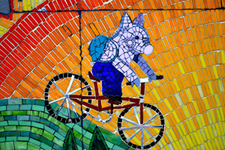A Sampling of KWin Tiling Scripts
KDE Tiling Solutions

Photo by Ralph Katieb on Unsplash
If you want to reap the benefits of tiling desktops on KDE Plasma, check out these KWin script extensions.
A tiling desktop arranges open windows in a grid. Linux abounds with them, including awesome, i3, XMonad, and dwm. Tiling desktops have always been popular among developers, but the average user has been slower to adopt them, probably because tiling is usually controlled from a keyboard rather than with a mouse. In addition, solutions such as virtual workspaces and Plasma Activities often are easier to use. Recently, however, tiling desktops have undergone a revival, partly due to the introduction of tiling in the last few Windows releases, and, more recently, thanks to Pop!_OS’s user-friendly desktop implementation.
But what if you want to use KDE Plasma? Then one of the various script extensions available for KWin, the Plasma window manager, may be just what you need. If some of the scripts described here are not as fully featured as a tiling desktop environment, many are more than enough for most users. What follows is not a complete list, just a representative one. For example, I don't include a family of scripts (among them Quick Tile 2 and Better Quick Tiles), which was designed to add features to KWin’s built-in Quick Tiles, because most of its features are now available routinely in other tiling scripts.
The Benefits of Tiling
Tiling is used primarily to reduce the clutter of open windows on the desktop. On a tiling desktop, each open window is always visible. There is no need for users to search through stacks of windows or to use a utility to minimize all open windows and show only the desktop. In addition, a window can be removed from the grid to float on top of others. If the size of the windows becomes too small, then a virtual workspace can be started to display the overflow. Loosely speaking, tiling can be compared to tabs on a web browser, with the exception that tiling is often harder to learn thanks to the use of keyboard controls.
[...]
Buy Linux Magazine
Subscribe to our Linux Newsletters
Find Linux and Open Source Jobs
Subscribe to our ADMIN Newsletters
Support Our Work
Linux Magazine content is made possible with support from readers like you. Please consider contributing when you’ve found an article to be beneficial.

News
-
AerynOS Alpha Release Available
With a choice of several desktop environments, AerynOS 2025.08 is almost ready to be your next operating system.
-
AUR Repository Still Under DDoS Attack
Arch User Repository continues to be under a DDoS attack that has been going on for more than two weeks.
-
RingReaper Malware Poses Danger to Linux Systems
A new kind of malware exploits modern Linux kernels for I/O operations.
-
Happy Birthday, Linux
On August 25, Linux officially turns 34.
-
VirtualBox 7.2 Has Arrived
With early support for Linux kernel 6.17 and other new additions, VirtualBox 7.2 is a must-update for users.
-
Linux Mint 22.2 Beta Available for Testing
Some interesting new additions and improvements are coming to Linux Mint. Check out the Linux Mint 22.2 Beta to give it a test run.
-
Debian 13.0 Officially Released
After two years of development, the latest iteration of Debian is now available with plenty of under-the-hood improvements.
-
Upcoming Changes for MXLinux
MXLinux 25 has plenty in store to please all types of users.
-
A New Linux AI Assistant in Town
Newelle, a Linux AI assistant, works with different LLMs and includes document parsing and profiles.
-
Linux Kernel 6.16 Released with Minor Fixes
The latest Linux kernel doesn't really include any big-ticket features, just a lot of lines of code.

